INTERNATIONAL
STANDARD
BS ISO/IEC 27005:2011
ISO/IEC
27005
Second edition
2011-06-01
Information technology — Security
techniques — Information security risk
management
Technologies de l'information — Techniques de sécurité — Gestion des
risques liés à la sécurité de l'information
t
e
n
l
.
k
o
b
u
k
.
w
w
w
KlubOK.net�
I
S
B
)
c
(
d
t
i
L
e
n
N
y
r
a
n
B
y
b
i
d
e
t
u
b
i
r
t
s
D
i
BS ISO/IEC 27005:2011
ISO/IEC 27005:2011(E)
Contents
Page
Foreword .............................................................................................................................................................v
Introduction........................................................................................................................................................vi
1
Scope......................................................................................................................................................1
Normative references............................................................................................................................1
2
Terms and definitions ...........................................................................................................................1
3
4
Structure of this International Standard .............................................................................................5
Background............................................................................................................................................6
5
Overview of the information security risk management process ....................................................7
6
7
Context establishment........................................................................................................................10
General considerations.......................................................................................................................10
7.1
7.2
Basic Criteria .......................................................................................................................................10
7.2.1 Risk management approach ..............................................................................................................10
7.2.2 Risk evaluation criteria .......................................................................................................................10
7.2.3
Impact criteria ......................................................................................................................................11
7.2.4 Risk acceptance criteria .....................................................................................................................11
Scope and boundaries........................................................................................................................12
7.3
7.4
Organization for information security risk management ................................................................12
Information security risk assessment...............................................................................................13
8
General description of information security risk assessment .......................................................13
8.1
8.2
Risk identification................................................................................................................................13
Introduction to risk identification ......................................................................................................13
8.2.1
Identification of assets........................................................................................................................14
8.2.2
8.2.3
Identification of threats.......................................................................................................................14
Identification of existing controls......................................................................................................15
8.2.4
Identification of vulnerabilities ..........................................................................................................15
8.2.5
8.2.6
Identification of consequences..........................................................................................................16
8.3
Risk analysis........................................................................................................................................17
8.3.1 Risk analysis methodologies .............................................................................................................17
8.3.2 Assessment of consequences...........................................................................................................18
8.3.3 Assessment of incident likelihood ....................................................................................................18
8.3.4 Level of risk determination.................................................................................................................19
8.4
Risk evaluation ....................................................................................................................................19
Information security risk treatment ...................................................................................................20
9
9.1
General description of risk treatment ...............................................................................................20
© ISO/IEC 2011 – All rights reserved
iii
KlubOK.net�
I
S
B
)
c
(
d
t
i
L
e
n
N
y
r
a
n
B
y
b
i
d
e
t
u
b
i
r
t
s
D
i
BS ISO/IEC 27005:2011
ISO/IEC 27005:2011(E)
Risk modification.................................................................................................................................22
9.2
Risk retention.......................................................................................................................................23
9.3
Risk avoidance.....................................................................................................................................23
9.4
Risk sharing .........................................................................................................................................23
9.5
Information security risk acceptance ................................................................................................24
10
Information security risk communication and consultation ...........................................................24
11
12
Information security risk monitoring and review .............................................................................25
12.1 Monitoring and review of risk factors................................................................................................25
12.2 Risk management monitoring, review and improvement................................................................26
Annex A (informative) Defining the scope and boundaries of the information security risk
management process..........................................................................................................................28
Study of the organization....................................................................................................................28
A.1
List of the constraints affecting the organization ............................................................................29
A.2
List of the legislative and regulatory references applicable to the organization..........................31
A.3
A.4
List of the constraints affecting the scope .......................................................................................31
Annex B (informative) Identification and valuation of assets and impact assessment.............................33
B.1
Examples of asset identification........................................................................................................33
B.1.1 The identification of primary assets ..................................................................................................33
B.1.2 List and description of supporting assets ........................................................................................34
B.2
Asset valuation ....................................................................................................................................38
B.3
Impact assessment..............................................................................................................................41
Annex C (informative) Examples of typical threats .......................................................................................42
Annex D (informative) Vulnerabilities and methods for vulnerability assessment ....................................45
D.1
Examples of vulnerabilities ................................................................................................................45
D.2
Methods for assessment of technical vulnerabilities ......................................................................48
Annex E (informative) Information security risk assessment approaches .................................................50
E.1
High-level information security risk assessment.............................................................................50
E.2
Detailed information security risk assessment................................................................................51
E.2.1 Example 1 Matrix with predefined values .........................................................................................52
E.2.2 Example 2 Ranking of Threats by Measures of Risk .......................................................................54
E.2.3 Example 3 Assessing a value for the likelihood and the possible consequences of risks.........54
Annex F (informative) Constraints for risk modification...............................................................................56
Annex G (informative) Differences in definitions between ISO/IEC 27005:2008 and ISO/IEC
27005:2011............................................................................................................................................58
Bibliography ......................................................................................................................................................68
iv
© ISO/IEC 2011 – All rights reserved
KlubOK.net�
I
S
B
)
c
(
d
t
i
L
e
n
N
y
r
a
n
B
y
b
i
d
e
t
u
b
i
r
t
s
D
i
BS ISO/IEC 27005:2011
ISO/IEC 27005:2011(E)
Foreword
ISO (the International Organization for Standardization) and IEC (the International Electrotechnical
Commission) form the specialized system for worldwide standardization. National bodies that are members of
ISO or IEC participate in the development of International Standards through technical committees
established by the respective organization to deal with particular fields of technical activity. ISO and IEC
technical committees collaborate in fields of mutual interest. Other international organizations, governmental
and non-governmental, in liaison with ISO and IEC, also take part in the work. In the field of information
technology, ISO and IEC have established a joint technical committee, ISO/IEC JTC 1.
International Standards are drafted in accordance with the rules given in the ISO/IEC Directives, Part 2.
The main task of the joint technical committee is to prepare International Standards. Draft International
Standards adopted by the joint technical committee are circulated to national bodies for voting. Publication as
an International Standard requires approval by at least 75 % of the national bodies casting a vote.
Attention is drawn to the possibility that some of the elements of this document may be the subject of patent
rights. ISO and IEC shall not be held responsible for identifying any or all such patent rights.
ISO/IEC 27005 was prepared by Joint Technical Committee ISO/IEC JTC 1, Information technology,
Subcommittee SC 27, IT Security techniques.
This second edition cancels and replaces the first edition (ISO/IEC 27005:2008) which has been technically
revised.
© ISO/IEC 2011 – All rights reserved
v
KlubOK.net�
BS ISO/IEC 27005:2011
ISO/IEC 27005:2011(E)
Introduction
This International Standard provides guidelines for information security risk management in an organization,
supporting in particular the requirements of an information security management (ISMS) according to
ISO/IEC 27001. However, this International Standard does not provide any specific method for information
security risk management. It is up to the organization to define their approach to risk management, depending
for example on the scope of the ISMS, context of risk management, or industry sector. A number of existing
methodologies can be used under the framework described in this International Standard to implement the
requirements of an ISMS.
This International Standard is relevant to managers and staff concerned with information security risk
management within an organization and, where appropriate, external parties supporting such activities.
I
S
B
)
c
(
d
t
i
i
L
e
n
N
y
r
a
n
B
y
b
d
e
t
u
b
i
r
t
s
D
i
vi
© ISO/IEC 2011 – All rights reserved
KlubOK.net�
I
S
B
)
c
(
d
t
i
L
e
n
N
y
r
a
n
B
y
b
i
d
e
t
u
b
i
r
t
s
D
i
INTERNATIONAL STANDARD
BS ISO/IEC 27005:2011
ISO/IEC 27005:2011(E)
Information technology — Security techniques — Information
security risk management
1 Scope
This International Standard provides guidelines for information security risk management.
This International Standard supports the general concepts specified in ISO/IEC 27001 and is designed to
assist the satisfactory implementation of information security based on a risk management approach.
Knowledge of the concepts, models, processes and terminologies described in ISO/IEC 27001 and
ISO/IEC 27002 is important for a complete understanding of this International Standard.
This International Standard is applicable to all types of organizations (e.g. commercial enterprises,
government agencies, non-profit organizations) which intend to manage risks that could compromise the
organization’s information security.
2 Normative references
The following referenced documents are indispensable for the application of this document. For dated
references, only the edition cited applies. For undated references, the latest edition of the referenced
document (including any amendments) applies.
ISO/IEC 27000, Information technology — Security techniques — Information security management
systems — Overview and vocabulary
ISO/IEC 27001:2005, Information technology — Security techniques — Information security management
systems — Requirements
3 Terms and definitions
For the purposes of this document, the terms and definitions given in ISO/IEC 27000 and the following apply.
NOTE Differences in definitions between ISO/IEC 27005:2008 and this International Standard are shown in Annex G.
3.1
consequence
outcome of an event (3.3) affecting objectives
[ISO Guide 73:2009]
NOTE 1 An event can lead to a range of consequences.
NOTE 2 A consequence can be certain or uncertain and in the context of information security is usually negative.
NOTE 3 Consequences can be expressed qualitatively or quantitatively.
NOTE 4
Initial consequences can escalate through knock-on effects.
© ISO/IEC 2011 – All rights reserved
1
KlubOK.net�
BS ISO/IEC 27005:2011
ISO/IEC 27005:2011(E)
3.2
control
measure that is modifying risk (3.9)
[ISO Guide 73:2009]
NOTE 1 Controls for information security include any process, policy, procedure, guideline, practice or organizational
structure, which can be administrative, technical, management, or legal in nature which modify information security risk.
NOTE 2 Controls may not always exert the intended or assumed modifying effect.
NOTE 3 Control is also used as a synonym for safeguard or countermeasure.
3.3
event
occurrence or change of a particular set of circumstances
[ISO Guide 73:2009]
NOTE 1
An event can be one or more occurrences, and can have several causes.
NOTE 2
An event can consist of something not happening.
NOTE 3
An event can sometimes be referred to as an “incident” or “accident”.
3.4
external context
external environment in which the organization seeks to achieve its objectives
[ISO Guide 73:2009]
NOTE
External context can include:
I
S
B
)
c
(
d
t
i
L
e
n
N
y
r
a
n
B
y
b
i
d
e
t
u
b
i
r
t
s
D
i
⎯
⎯
⎯
the cultural, social, political, legal, regulatory, financial, technological, economic, natural and
competitive environment, whether international, national, regional or local;
key drivers and trends having impact on the objectives of the organization; and
relationships with, and perceptions and values of, external stakeholders.
3.5
internal context
internal environment in which the organization seeks to achieve its objectives
[ISO Guide 73:2009]
NOTE
Internal context can include:
⎯
⎯
⎯
⎯
⎯
⎯
⎯
⎯
governance, organizational structure, roles and accountabilities;
policies, objectives, and the strategies that are in place to achieve them;
the capabilities, understood in terms of resources and knowledge (e.g. capital, time, people,
processes, systems and technologies);
information systems, information flows and decision-making processes (both formal and informal);
relationships with, and perceptions and values of, internal stakeholders;
the organization's culture;
standards, guidelines and models adopted by the organization; and
form and extent of contractual relationships.
2
© ISO/IEC 2011 – All rights reserved
KlubOK.net�
I
S
B
)
c
(
d
t
i
L
e
n
N
y
r
a
n
B
y
b
i
d
e
t
u
b
i
r
t
s
D
i
BS ISO/IEC 27005:2011
ISO/IEC 27005:2011(E)
3.6
level of risk
magnitude of a risk (3.9), expressed in terms of the combination of consequences (3.1) and their likelihood
(3.7)
[ISO Guide 73:2009]
3.7
likelihood
chance of something happening
[ISO Guide 73:2009]
NOTE 1
In risk management terminology, the word “likelihood” is used to refer to the chance of something happening,
whether defined, measured or determined objectively or subjectively, qualitatively or quantitatively, and described using
general terms or mathematically (such as a probability or a frequency over a given time period).
NOTE 2
The English term “likelihood” does not have a direct equivalent in some languages; instead, the equivalent of
the term “probability” is often used. However, in English, “probability” is often narrowly interpreted as a mathematical term.
Therefore, in risk management terminology, “likelihood” is used with the intent that it should have the same broad
interpretation as the term “probability” has in many languages other than English.
3.8
residual risk
risk (3.9) remaining after risk treatment (3.17)
[ISO Guide 73:2009]
NOTE 1 Residual risk can contain unidentified risk.
NOTE 2 Residual risk can also be known as “retained risk”.
3.9
risk
effect of uncertainty on objectives
[ISO Guide 73:2009]
NOTE 1
An effect is a deviation from the expected — positive and/or negative.
NOTE 2 Objectives can have different aspects (such as financial, health and safety, information security, and
environmental goals) and can apply at different levels (such as strategic, organization-wide, project, product and process).
NOTE 3 Risk is often characterized by reference to potential events (3.3) and consequences (3.1), or a combination of
these.
NOTE 4
security event and the associated likelihood (3.9) of occurrence.
Information security risk is often expressed in terms of a combination of the consequences of an information
NOTE 5 Uncertainty is the state, even partial, of deficiency of information related to, understanding or knowledge of, an
event, its consequence, or likelihood.
NOTE 6
asset or group of information assets and thereby cause harm to an organization.
Information security risk is associated with the potential that threats will exploit vulnerabilities of an information
3.10
risk analysis
process to comprehend the nature of risk and to determine the level of risk (3.6)
[ISO Guide 73:2009]
© ISO/IEC 2011 – All rights reserved
3
KlubOK.net�
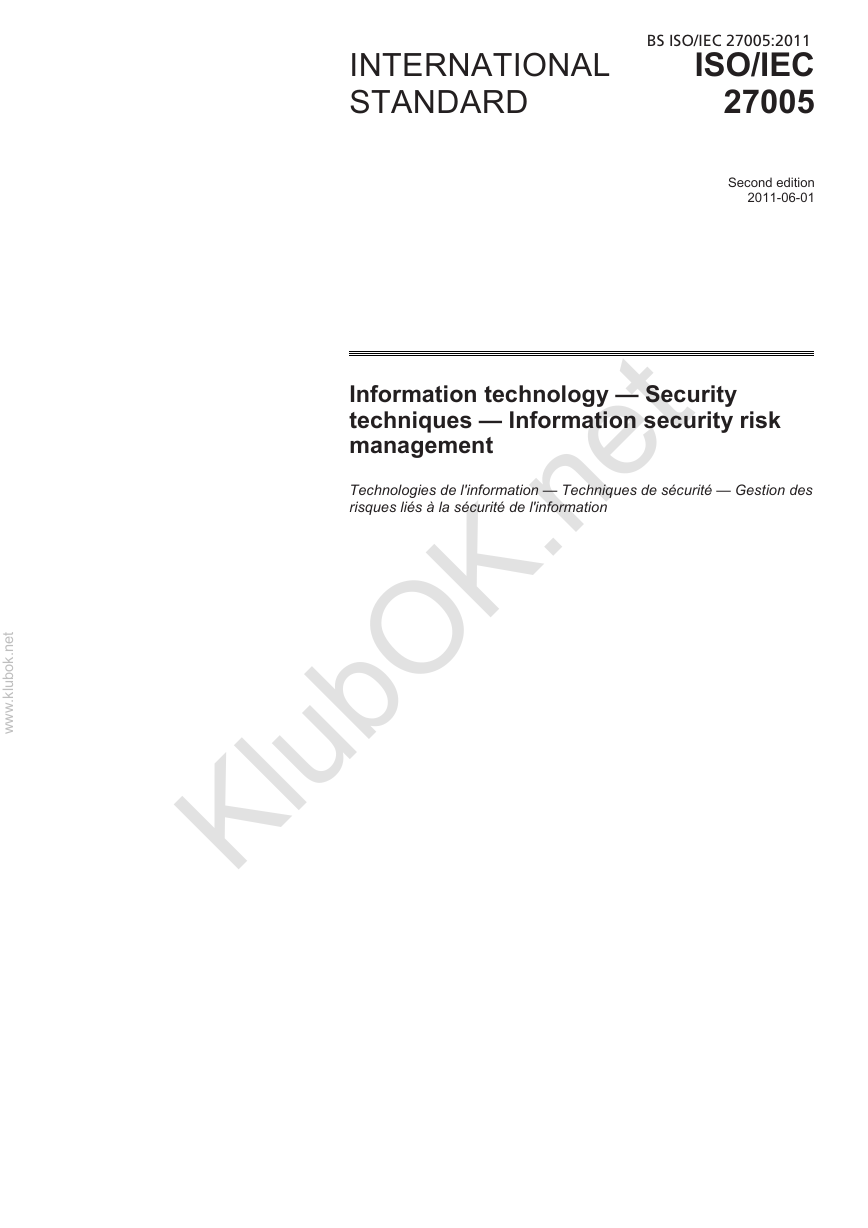
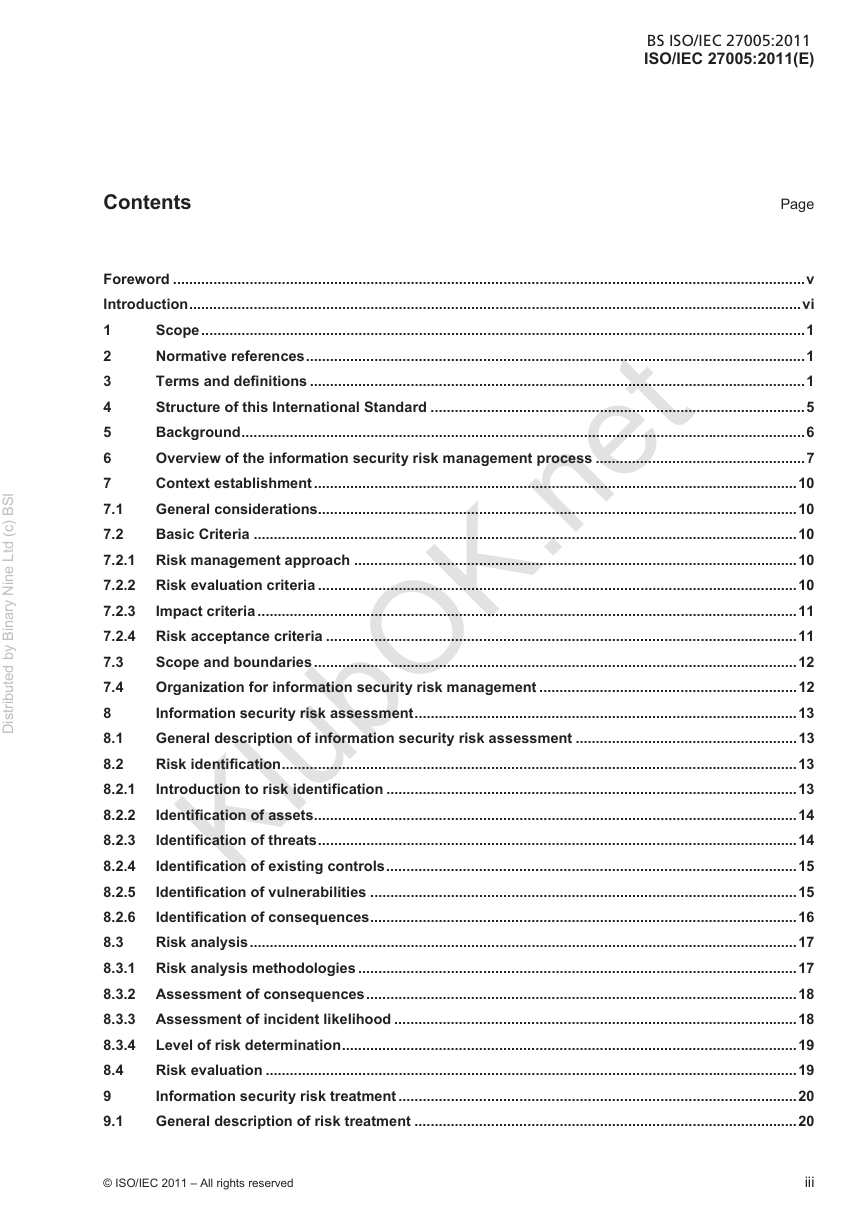
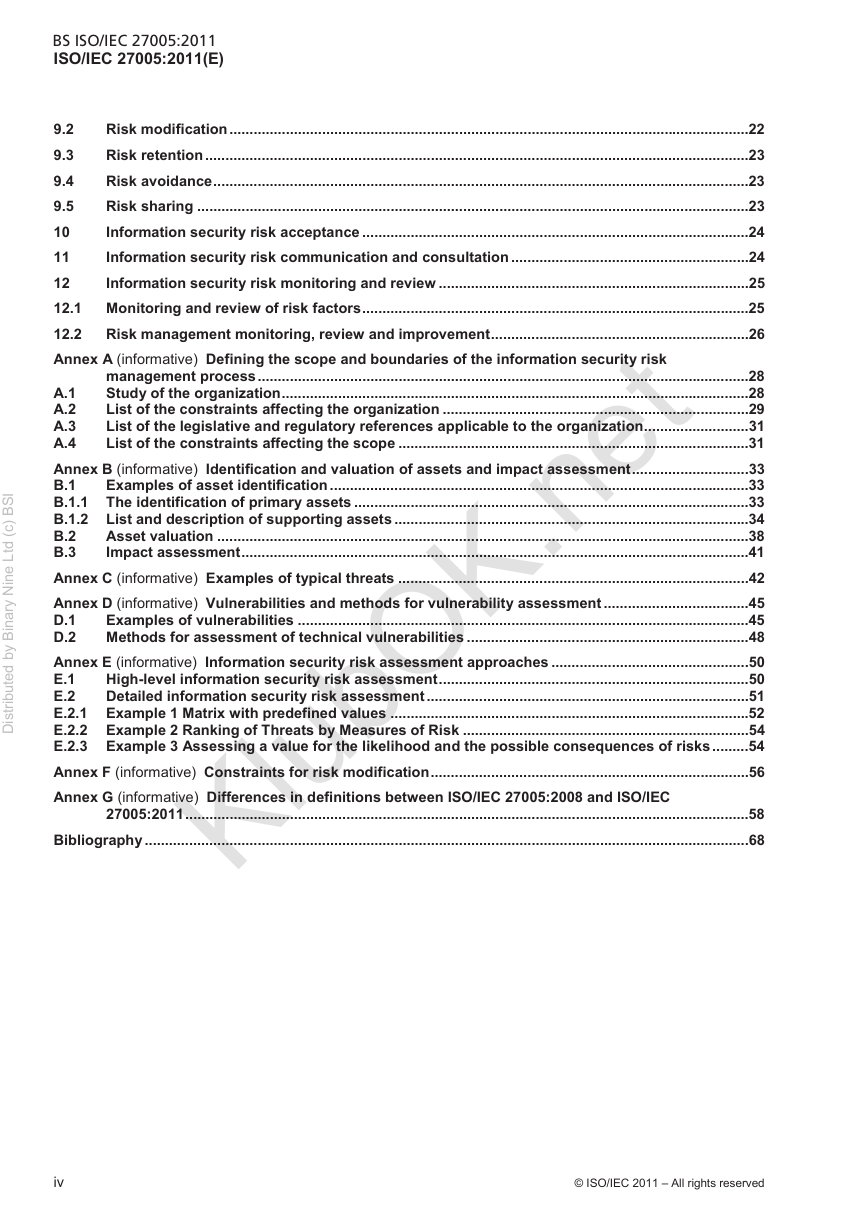
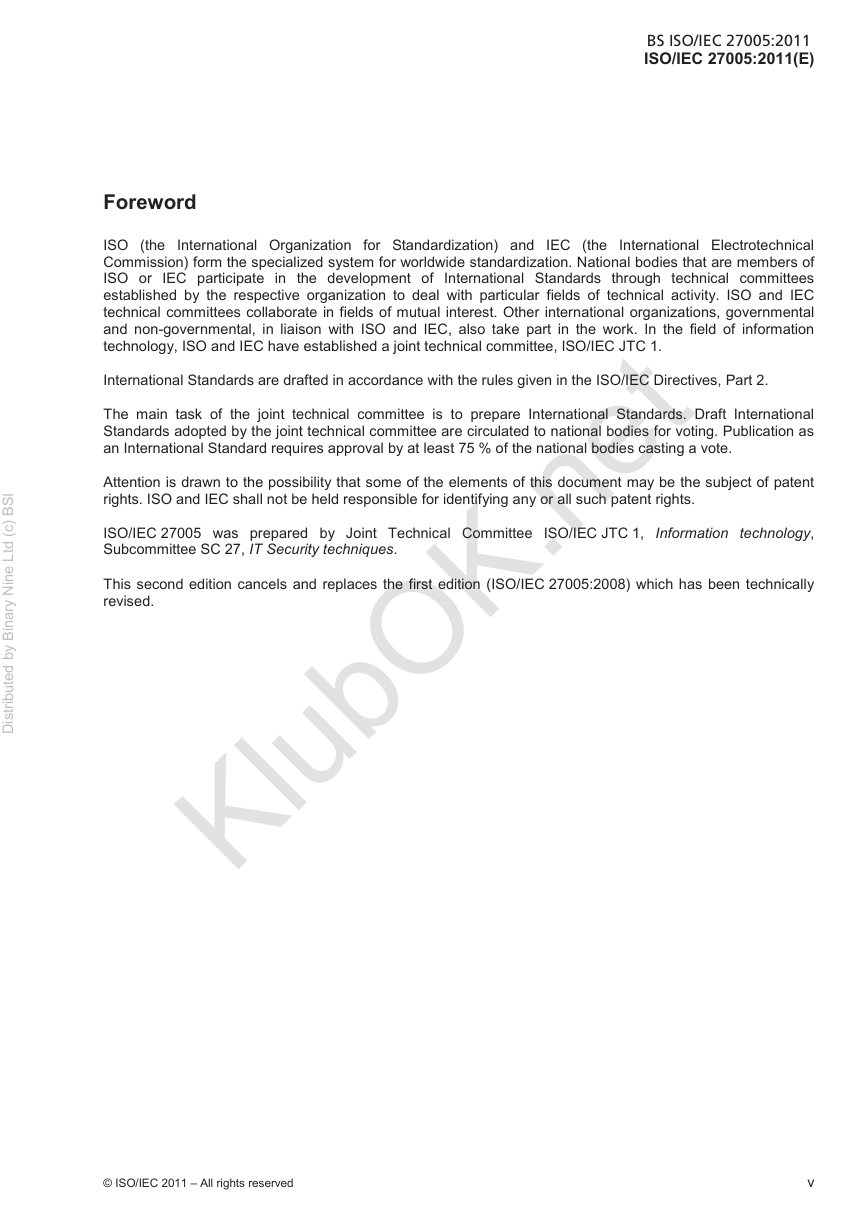
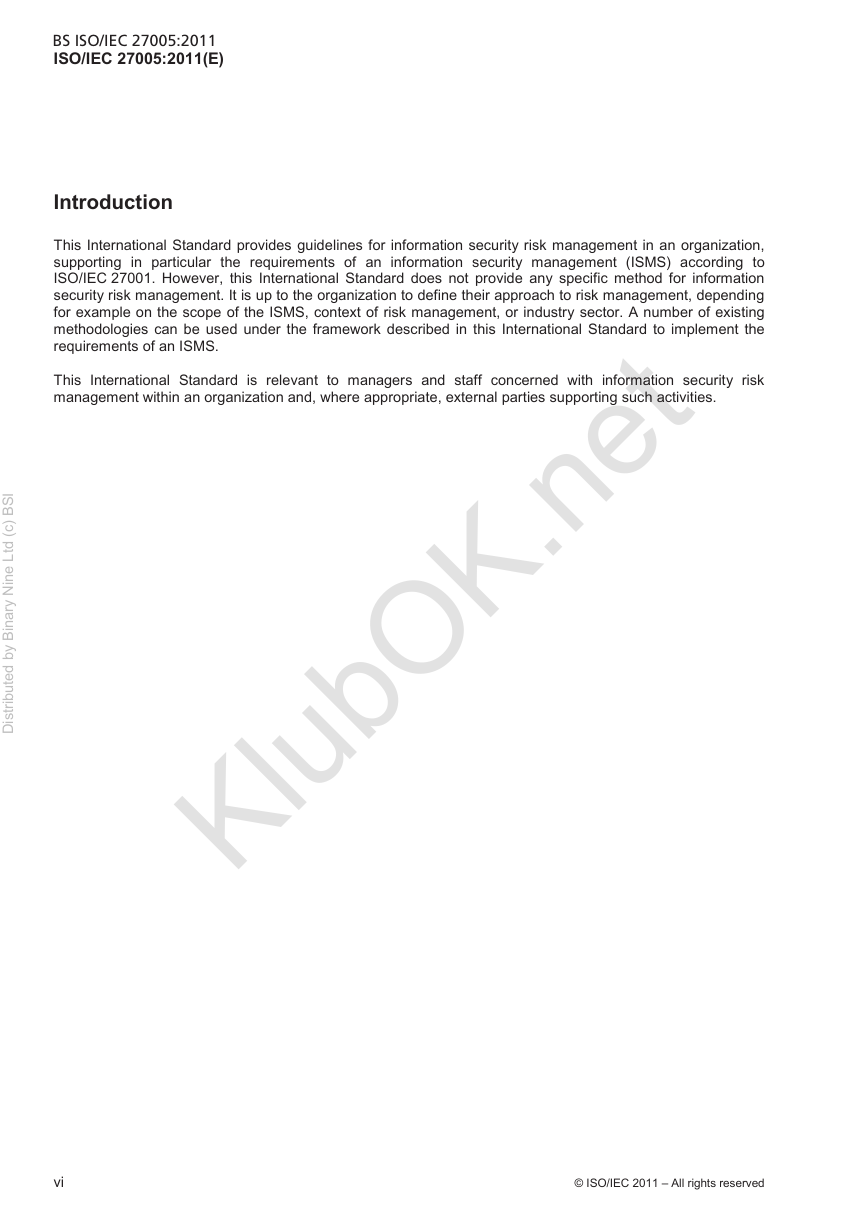

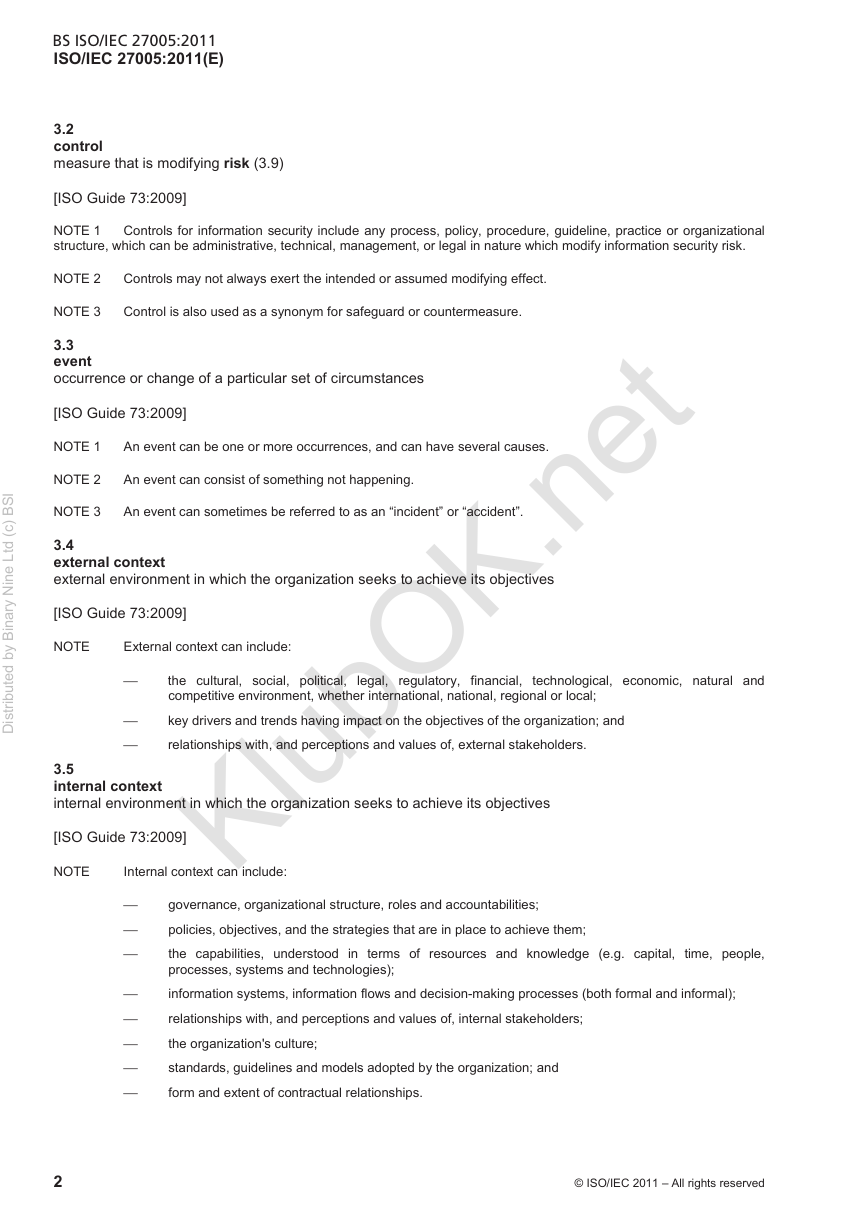
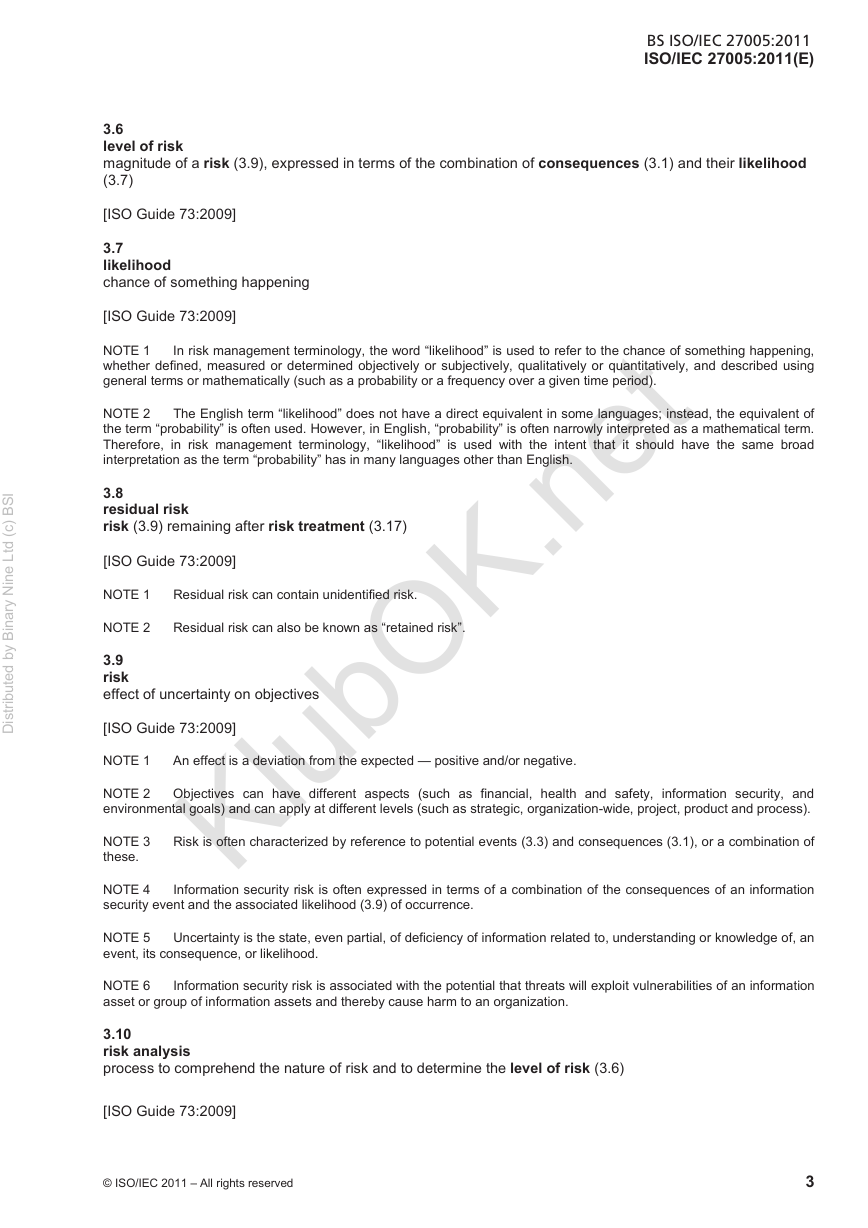








 2023年江西萍乡中考道德与法治真题及答案.doc
2023年江西萍乡中考道德与法治真题及答案.doc 2012年重庆南川中考生物真题及答案.doc
2012年重庆南川中考生物真题及答案.doc 2013年江西师范大学地理学综合及文艺理论基础考研真题.doc
2013年江西师范大学地理学综合及文艺理论基础考研真题.doc 2020年四川甘孜小升初语文真题及答案I卷.doc
2020年四川甘孜小升初语文真题及答案I卷.doc 2020年注册岩土工程师专业基础考试真题及答案.doc
2020年注册岩土工程师专业基础考试真题及答案.doc 2023-2024学年福建省厦门市九年级上学期数学月考试题及答案.doc
2023-2024学年福建省厦门市九年级上学期数学月考试题及答案.doc 2021-2022学年辽宁省沈阳市大东区九年级上学期语文期末试题及答案.doc
2021-2022学年辽宁省沈阳市大东区九年级上学期语文期末试题及答案.doc 2022-2023学年北京东城区初三第一学期物理期末试卷及答案.doc
2022-2023学年北京东城区初三第一学期物理期末试卷及答案.doc 2018上半年江西教师资格初中地理学科知识与教学能力真题及答案.doc
2018上半年江西教师资格初中地理学科知识与教学能力真题及答案.doc 2012年河北国家公务员申论考试真题及答案-省级.doc
2012年河北国家公务员申论考试真题及答案-省级.doc 2020-2021学年江苏省扬州市江都区邵樊片九年级上学期数学第一次质量检测试题及答案.doc
2020-2021学年江苏省扬州市江都区邵樊片九年级上学期数学第一次质量检测试题及答案.doc 2022下半年黑龙江教师资格证中学综合素质真题及答案.doc
2022下半年黑龙江教师资格证中学综合素质真题及答案.doc